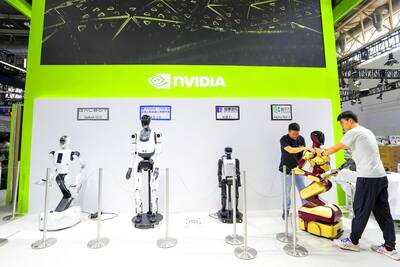The Asia-Pacific region is the world’s largest broadband market with 39 percent of the total, the largest mobile phone market with 1.4 billion subscribers and claims 42 percent of the world’s Internet users, a UN report said yesterday.
By the middle of this year, China and India alone had over 600 million and 280 million mobile phone subscribers respectively, representing nearly a quarter of the world’s total, said a report on telecommunications and information communication technology indicators by the International Telecommunication Union (ITU) released in Bangkok.
The Asia-Pacific region notched up several “superlatives” in this year’s report.
The Philippines, for instance, emerged as the text-messaging champion of the world. Filipinos send 650 text messages per subscriber per month, the report said.
CELLPHONE LEADER
The region claims almost half the world’s fixed-telephone subscribers, with close to 2 billion, and leads in mobile phone subscriptions at 1.4 billion.
The average annual mobile growth over the last five years has been almost 30 percent in the region, with mobile penetration nearing 40 percent, it said.
“In terms of broadband access, [the] Asia-Pacific has made remarkable progress in the past few years, with subscriber numbers growing almost five-fold in five years: from 27 million at the beginning of 2003 to 133 million at the start of 2008,” said the report, which was released at the ITU Telecom Asia 2008 conference held this week in Bangkok.
South Korea is world leader in terms of the percentage of households with fixed broadband access, while South Korea, Hong Kong and Japan are international leaders in terms of the proportion of households with fiber-optic connections, essential for supporting the next generation of ultra-high-speed Internet applications.
GROWING DIVIDE
But the connectivity is far from universal in Asia, with a growing divide between “the haves and have-nots,” the report noted.
“The regional broadband divide is striking, with poor economies having a close-to-zero broadband penetration, compared to that of rich economies where one in four persons is a broadband subscriber,” it said.
By the end of last year, 97 per cent of the region’s more than 120 million mobile broadband subscribers were in high-income economies.
“While the region’s high-income economies are pushing the frontier of broadband bandwidth to a point where applications have yet to catch up, many Asia-Pacific developing economies are bandwidth starved, inhibiting the development of their information societies,” the report said.
CHALLENGES
The report said the use of broadband technologies could help poorer countries overcome many challenges and become a catalyst for development.
“Governments must recognize its importance and formulate concrete broadband policies and targets, while providing incentives for achieving them,” the report said. “Broadband prices could be reduced by encouraging new operators to enter the markets.”

UNCERTAINTIES: Exports surged 34.1% and private investment grew 7.03% to outpace expectations in the first half, although US tariffs could stall momentum The Chung-Hua Institution for Economic Research (CIER, 中華經濟研究院) yesterday raised its GDP growth forecast to 3.05 percent this year on a robust first-half performance, but warned that US tariff threats and external uncertainty could stall momentum in the second half of the year. “The first half proved exceptionally strong, allowing room for optimism,” CIER president Lien Hsien-ming (連賢明) said. “But the growth momentum may slow moving forward due to US tariffs.” The tariff threat poses definite downside risks, although the scale of the impact remains unclear given the unpredictability of US President Donald Trump’s policies, Lien said. Despite the headwinds, Taiwan is likely

When Lika Megreladze was a child, life in her native western Georgian region of Guria revolved around tea. Her mother worked for decades as a scientist at the Soviet Union’s Institute of Tea and Subtropical Crops in the village of Anaseuli, Georgia, perfecting cultivation methods for a Georgian tea industry that supplied the bulk of the vast communist state’s brews. “When I was a child, this was only my mum’s workplace. Only later I realized that it was something big,” she said. Now, the institute lies abandoned. Yellowed papers are strewn around its decaying corridors, and a statue of Soviet founder Vladimir Lenin

READY TO BUY: Shortly after Nvidia announced the approval, Chinese firms scrambled to order the H20 GPUs, which the company must send to the US government for approval Nvidia Corp chief executive officer Jensen Huang (黃仁勳) late on Monday said the technology giant has won approval from US President Donald Trump’s administration to sell its advanced H20 graphics processing units (GPUs) used to develop artificial intelligence (AI) to China. The news came in a company blog post late on Monday and Huang also spoke about the coup on China’s state-run China Global Television Network in remarks shown on X. “The US government has assured Nvidia that licenses will be granted, and Nvidia hopes to start deliveries soon,” the post said. “Today, I’m announcing that the US government has approved for us

UNIFYING OPPOSITION: Numerous companies have registered complaints over the potential levies, bringing together rival automakers in voicing their reservations US President Donald Trump is readying plans for industry-specific tariffs to kick in alongside his country-by-country duties in two weeks, ramping up his push to reshape the US’ standing in the global trading system by penalizing purchases from abroad. Administration officials could release details of Trump’s planned 50 percent duty on copper in the days before they are set to take effect on Friday next week, a person familiar with the matter said. That is the same date Trump’s “reciprocal” levies on products from more than 100 nations are slated to begin. Trump on Tuesday said that he is likely to impose tariffs